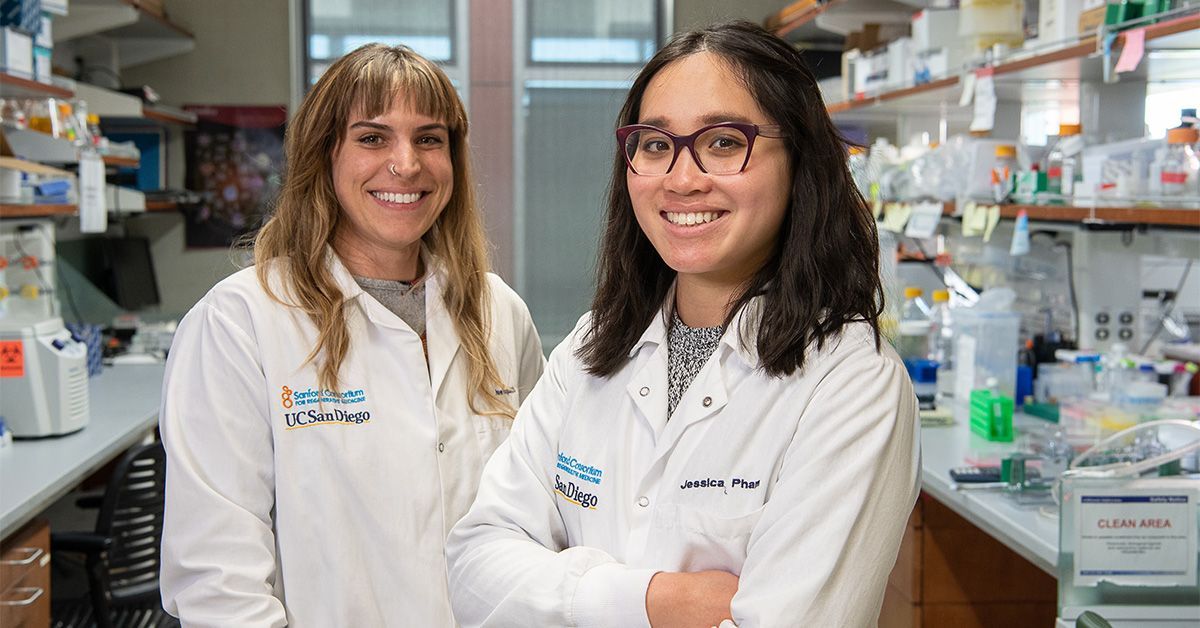Shooting for the Stars
UC San Diego scientists are sending cells into space, and health science into the future.
Story by:
Media contact:
Published Date
Story by:
Media contact:
Share This:
Article Content
This story is from the 2024 issue of Discoveries, a UC San Diego Health Sciences magazine.
Jessica Pham stared at the grey skies above her with nervous anticipation. She had arrived at the Kennedy Space Center that morning with a shipment of precious cargo: multiple batches of human stem cells. Over the previous month, Pham had meticulously tended to these cells, preparing them for their upcoming journey to the International Space Station (ISS). But after Pham and her samples were both overnighted to Florida, a dense layer of clouds had stalled the next leg of the trip.
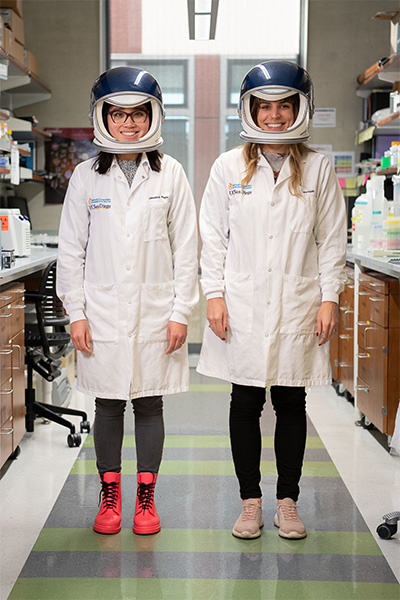
From left to right: Rising stars Jessica Pham and Jane Isquith use space to study stem cell health in the Jamieson Lab at UC San Diego. Photo credit: UC San Diego Health Sciences
“All you need is a five-minute window of clear skies for the rocket to be able to launch,” said Pham, a senior researcher in the Jamieson Lab at UC San Diego School of Medicine.
The rocket she refers to is a Space X Falcon, which routinely ships supplies into low Earth orbit to restock the ISS. Researchers like Pham are now taking advantage of these commercial launches to send experiments to space.
Suddenly, the fog began to lift over launch site, along with the scientists’ spirits. A rush of action followed, and before they knew it, the rocket was in the air and out of sight.
“Suddenly everyone around me was cheering and my family was calling to congratulate me from San Diego,” said Pham. “But it never really hits me until the day after. In those first few moments, it’s still all too surreal. I never thought anything I was working on would ever end up in outer space.”
For biomedical research at UC San Diego, the sky is no longer the limit.
Over the last five years, the university has become a pioneer in performing health science research in space. In a series of successful launches, UC San Diego scientists have sent various types of stem cells aboard the ISS, where the unique microgravity environment offers an unparalleled view into the molecular mechanisms of cancer and aging.
Much of the work is led by researchers affiliated with the UC San Diego Sanford Stem Cell Institute, established in 2022 with a $150 million gift from philanthropist T. Denny Sanford. Through collaborations with the National Aeronautics and Space Administration (NASA) and a growing list of space and biotech industry partners, the institute is now expanding its space programming across research, commercialization and education efforts.
"In those first few moments, it’s still all too surreal. I never thought anything I was working on would ever end up in outer space.”
“Microgravity is an extremely stressful environment for cells, so by conducting experiments in low Earth orbit, we are able to understand mechanisms of aging, inflammation and cancer evolution in a compressed time frame, and then use these findings to inform new therapeutic strategies,” said Catriona Jamieson, MD, PhD, professor at UC San Diego School of Medicine and director of the Sanford Stem Cell Institute. “If there is anything that our work has taught us so far, it’s that the future of stem cell science is in space.”
Why study cells in space?
When astronaut Scott Kelly returned from a year-long trip aboard the ISS, subsequent lab tests revealed numerous molecular changes in his blood. After this extended time in space, his blood cells showed DNA damage, shortened telomeres and heightened levels of precancerous markers. These sorts of things can be observed in blood cells on Earth, but only after decades of human aging.
Additional studies support the idea that the lack of gravity and exposure to the sun’s radiation in space can accelerate aging in human cells and promote their transformation into cancer cells. This is especially dangerous when it occurs in stem cells, such as those that produce our blood.
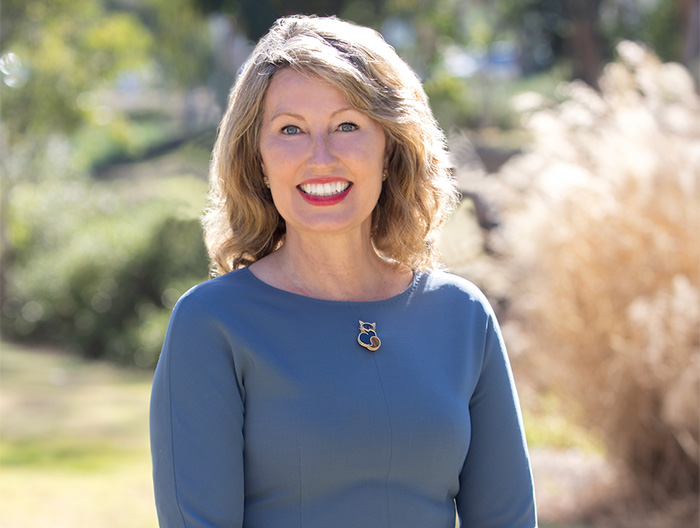
Adult stem cells are unspecialized cells that have yet to develop into a particular cell type. Under the right conditions, stem cells divide and turn into more specialized cells with a distinct function, such as blood cells, brain cells, bone cells or liver cells.
These properties make stem cells critical to the body’s ability to maintain and repair healthy tissues across a lifetime. But just like other cells in the body, stem cells also experience a progressive decline in their health and numbers as people age. This in turn reduces the body’s ability to regenerate new tissue, causing joints, blood vessels and other organs to get weaker over time.
Stem cells also live much longer than the more specialized cells they are designed to replace. This increases their chance of accumulating genetic mutations over time. It often only takes a few mutations for a cell to lose control over itself and start rapidly dividing, so stem cells are also especially prone to becoming the source of a cancerous tumor.
Physicians and scientists were therefore startled to find that the stressful environment of space was aging astronauts’ cells at such a rapid pace. Stem cell experts at UC San Diego immediately began to explore what was happening inside these cells, with the understanding that this would not only help us keep astronauts healthy — it could also teach us how to treat cancer and aging on Earth.
Researchers at the Sanford Stem Cell Institute are now using space as an ‘aging accelerator.’ The studies will help scientists and clinicians understand the cellular and molecular mechanisms of stem cell aging, inflammation and cancer, all without having to rely on lengthy and expensive clinical trials monitoring Earthbound humans as they age or develop disease in real time.
“Whether we’re looking at aging mice, putting cell cultures under oxidative stress, or manipulating genes associated with aging, we’re always seeking ways to model these processes at a more efficient scale."
Already, their initial experiments have confirmed that even in cultured cells, exposure to the microgravity environment of low Earth orbit can lead to precancerous genetic mutations, changes in telomere length and massive bursts of cell division.
“It’s increasingly clear that the way stem cells age depends on what they are exposed to, and the more we understand this process, the more precisely we can intercept cancer development and turn back the clock on human aging,” said Jamieson.
While sending cells into space might seem strange to some, the researchers point out that terrestrial labs already rely on artificial experimental manipulations to try to simulate the effects of aging.
“Whether we’re looking at aging mice, putting cell cultures under oxidative stress, or manipulating genes associated with aging, we’re always seeking ways to model these processes at a more efficient scale,” said Alysson Muotri, PhD, professor at UC San Diego School of Medicine and co-director of the UC San Diego Stem Cell Program. “Now we’re taking a different approach to speed up the aging process, and studying how it plays a role in cancer, liver disease and neurodegeneration.”
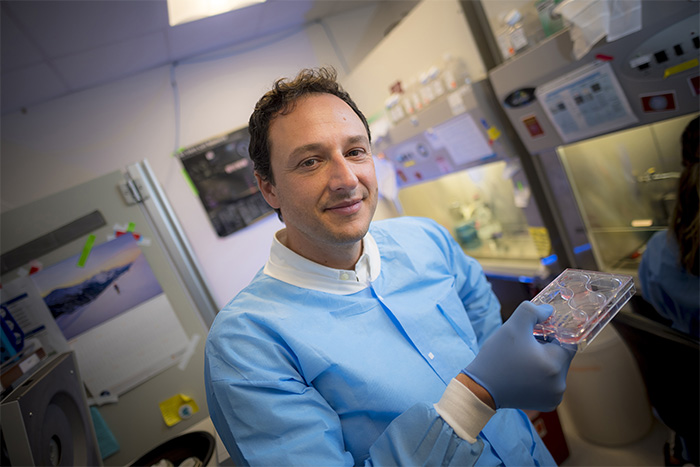
Alysson Muotri, PhD, leads the Integrated Space Stem Cell Orbital Research Center at UC San Diego with Catriona Jamieson, MD, PhD. Photo credit: Erik Jepsen/UC San Diego
Gaining momentum
Following a series of successful pilot studies, UC San Diego is now significantly expanding its scope of space research.
In one of their earliest experiments, Jamieson and colleagues found that several precancerous markers were elevated in blood stem cells after one month in space. Of particular note was the activation of ADAR1, an enzyme that edits RNA and promotes cancer proliferation and drug resistance.
In a follow-up study in 2023, the scientists sent tumor organoid models of leukemia, colon and breast cancer aboard the ISS and observed whether these cells behaved similarly to the blood stem cells. They also tested two ADAR1 inhibitors, Fedratinib and Rebecsinib, to see if the drugs could reverse the effects and prevent cancer progression. These experiments mark the start of a developing program to expand translational research and drug development in space.
Another line of experiments monitors the health of astronauts’ stem cells over time to learn how they are affected by spaceflight. Blood samples are collected from crew members before, during and immediately after the mission, followed by annual exams over the next five years. The longitudinal study will track the effects of the space environment on stem cell aging, immune function and cancer stem cell generation.
Research led by Tatiana Kisseleva, MD, PhD, professor at UC San Diego School of Medicine, is investigating the effects of stress and aging on liver stem cells. Kisseleva studies and treats ailments of the liver, such as fibrosis and steatohepatitis, a type of fatty liver disease. Her group is now interested in learning the impact of microgravity on liver function, which could provide insights into its dysfunction on Earth and the potential effects of space travel.
Another branch of research led by Muotri’s lab focuses on the effects of low Earth orbit on neural stem cells and brain organoids.
“Our data shows that microgravity can accelerate the aging of brain cells,” said Muotri. “We can now use this to simulate neurological aging and create novel laboratory models for late-onset diseases such as Alzheimer’s and dementia.”
In 2023, Muotri’s group began a new series of launches to further explore the molecular and cellular mechanisms of neurodegeneration in space.
“One month in space seems equivalent to about 10 years on Earth, so if we keep these brain organoids up there for six months, this could reveal a lot about the changes that occur in brain cells across our lifespan.”
Muotri says he’s already been approached by pharmaceutical companies interested in testing Alzheimer’s drugs on these rapidly aging organoids. He suggests that in the future, space stations could become factories for producing organoid models of aging-associated diseases.
“The progress isn’t incremental, it’s explosive,” said Jamieson. “I’ve never seen this level of scientific might coming together to support a new line of work.”
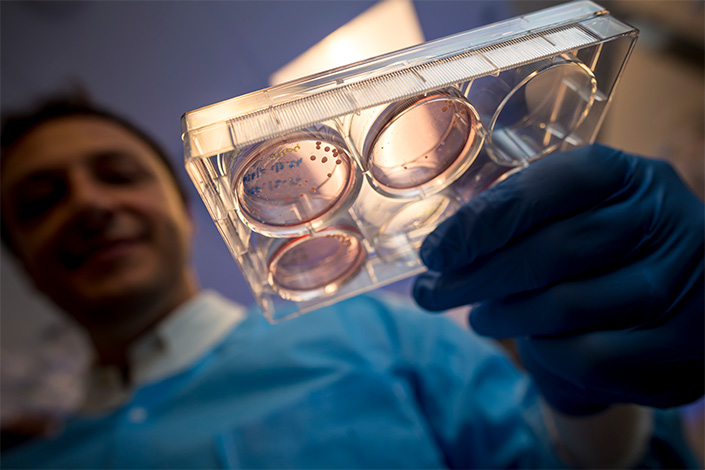
Commercializing space
The success of the university’s space research program is due, in part, to its strong collaborations with leaders in the space and biotech industries. These partnerships have allowed UC San Diego scientists to develop novel protocols for sending human cells aboard space stations and maintaining them there over weeks or months.
In a lab on Earth, cell cultures like these require constant maintenance by research staff, who ensure the cells are taken care of and getting all the nutrients they need to stay alive. To do this in space, the researchers relied on the CubeLab, a custom device designed and built by engineering company Space Tango to automate cell maintenance and allow researchers to monitor data remotely from Earth.
The researchers also forged partnerships with Axiom Space and Sierra Space, two companies leading the way in aerospace transportation. Future studies could take place on Axiom’s new commercial space station, equipped with state-of-the-art laboratory space and trained research staff.
With these pipelines in place, the Sanford Stem Cell Institute is increasingly focused on expanding its basic research findings into clinical trials and commercial products. This includes manufacturing novel drugs, biofilms and stem cell therapies in space, where the conditions make assembly faster and more cost-effective.
The institute is now developing strategic collaborations with San Diego biotechnology companies and global manufacturers to help execute this mission. This new industrial engine will help assess what aspects of scientific manufacturing can be done bigger, better and faster in space.
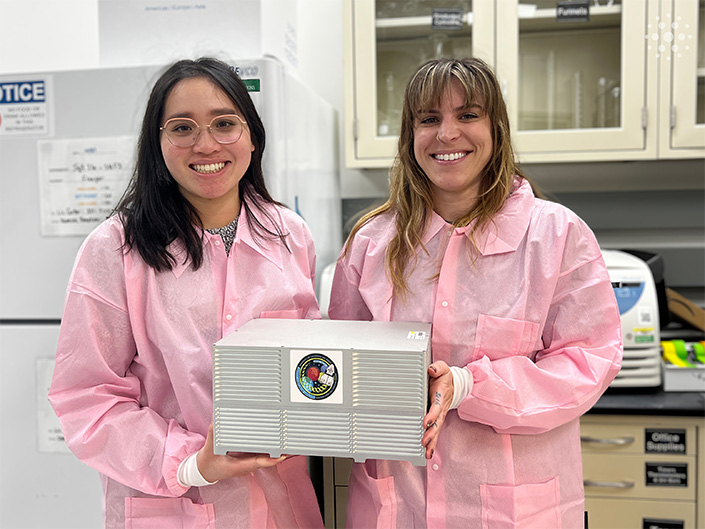
Jessica Pham (left) and Jane Isquith (right) helped develop the CubeLab. Photo credit: UC San Diego Health Sciences
“It’s becoming evident that space is a great place to do science and to translate discoveries into tangible goods,” said Jamieson. “The next thriving ecosystem of stem cell companies will be 250 miles overhead.”
Institute leaders say they’re witnessing the emergence of a new global economy based in space. While this creates new opportunities, it also inspires new questions.
“If we make discoveries and eventually new products in space, who owns and regulates that?” said Jamieson. “We don’t have a way of even thinking about that yet.”
“Right now, it’s the Wild West up there. We want to work with governmental agencies to get ahead of that. The sooner we do, the sooner patients will benefit.”
“It’s becoming evident that space is a great place to do science and to translate discoveries into tangible goods."
Training a space biologist
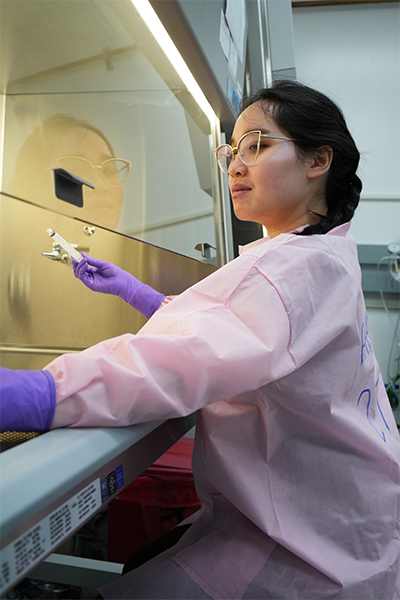
Jessica Pham prepares a "payload" of stem cells that will soon travel aboard NASA's ISS.
When describing these projects, Jamieson frequently notes the dedicated work of her lab staff, who have taken on the challenge of pioneering an entirely new research program.
“We put in so much effort to get this to work,” said Pham, who now serves as the lab’s first Stellar Mission Specialist. “The end product is very glamorous, but the process to get there was tough.”
To address the unique challenges of this work, institute leaders say we’ll need increased training and specialization of research staff, both on Earth and in space.
“You don’t need to be a pilot or a race car driver to go to space anymore,” said Jamieson. “In our current model we train astronauts to be cell biologists, but I think the future will have cell biologists training to be astronauts.”
The Sanford Stem Cell Institute now aims to develop and fund educational programming to train a new generation of space biologists.
“With the growing support of NASA, philanthropic funders and our partners in commercial spaceflight, this is just the beginning of a long line of exciting and impactful health science advances that will be enabled by space,” said Jamieson. “The time to invest in space science is now.”
Share This:
You May Also Like
Stay in the Know
Keep up with all the latest from UC San Diego. Subscribe to the newsletter today.
